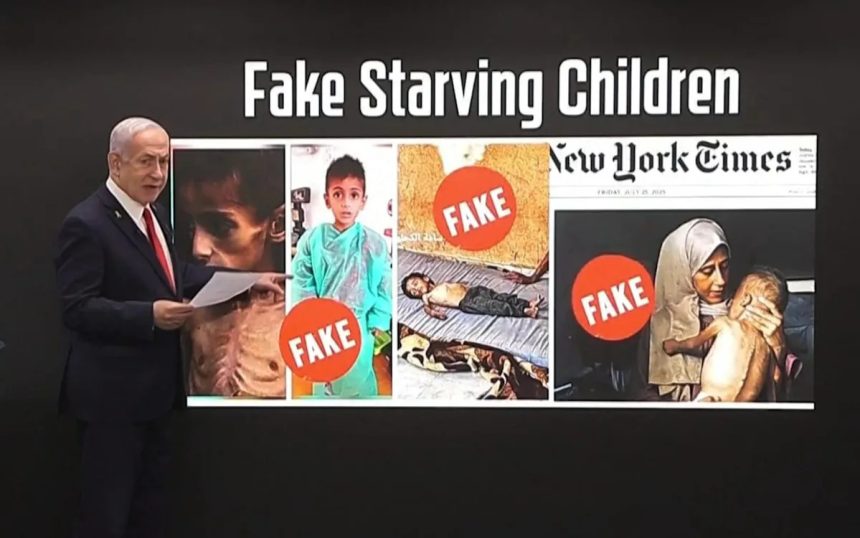Benjamin Netanyahu is considering legal action against The New York Times over a photograph of a malnourished child he has described as “fake”.
The Israeli prime minister accused the newspaper of defaming Israel with its coverage of the humanitarian crisis in Gaza.
A front-page photo of Mohammed Zakaria al-Mutawaq, an emaciated 18-month-old boy, sparked international outrage last month.
The child’s mother said he had been “born healthy” before suffering severe malnutrition.
Later reports revealed he had suffered from cerebral palsy and complications linked to a genetic disorder – details which were absent from the original piece.
At a press conference announcing his plans to expand military operations and occupy Gaza City, Mr Netanyahu accused the international press of having bought Hamas propaganda “hook, line, and sinker”.
He then displayed a picture of The New York Times front page from July 25 with the word “fake” branded across it, saying: “I’m looking right now into the possibility of a governmental suit against The New York Times, because this is outrageous.
“These are the three most celebrated photos, and they’re all fake. We won’t allow it to go unchallenged, and this is the purpose of this press conference. I hope you can open your eyes to the simple fact that Hamas lies.”
A photo of Mohammed Zakaria al-Mutawaq, the 18-month-old boy child pictured here, caused international outrage last month – Omar al-Qattaa/AFP
The New York Times updated the story to give readers “a greater understanding” of Mohammed’s situation, but defended its reporting.
A spokesman of the newspaper said: “After publication, we learned that a child shown in that story – in addition to being severely malnourished – also had pre-existing health problems. That additional information gave readers a greater understanding of his situation.”
“Attempts to threaten independent media providing vital information and accountability to the public are unfortunately an increasingly common playbook.”
The UN-backed Integrated Food Security Phase Classification (IPC) is a globally recognised system for classifying the severity and magnitude of food insecurity and malnutrition.
The IPC says that one in three people is now going without food for days at a time in Gaza.
Hospitals have treated more than 20,000 children for acute malnutrition since April. At least 16 children under five have died from hunger-related causes since mid-July.
“The worst-case scenario of famine is currently playing out in the Gaza Strip,” the IPC warned.
Satellite imagery released last month showed the hunger crisis was visible from space, as thousands of Palestinians could be seen crowding around aid trucks in desperation.

A satellite photo of crowds of starving Palestinians gathering around a distribution site affiliated with the Gaza Humanitarian Foundation in Khan Younis – AFP
Under heavy international pressure, Israel last week announced measures to let more aid into Gaza.
Mr Netanyahu insisted that “hundreds of trucks” had been allowed in, and said that if Israel was implementing “a starvation policy”, then “no one in Gaza would have survived after two years of war”.
He pointed to disturbing images of Evyatar David, a 24-year-old Israeli hostage who looked severely malnourished in a video released by Hamas. He said: “The only ones who are being deliberately starved in Gaza are our hostages.”
Several hundred Palestinians have been killed by Israel Defence Forces soldiers since May while heading toward food distribution sites and aid convoys, according to witnesses, local health officials and the United Nations human rights office.
The Israeli military claimed it had only fired warning shots and disputes the toll, which is thought to be well over 1,000 since May.
Credit: IDF
Speaking during a meeting with Sir Keir Starmer in Scotland last month, Donald Trump said there was “real starvation” in Gaza.
The US president added: “Those children look very hungry… that’s real starvation stuff. Nobody’s done anything great over there. The whole place is a mess… I told Israel maybe they have to do it a different way.”









